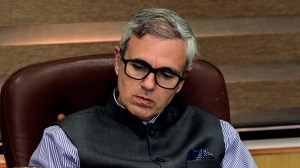P. Vaidyanathan Iyer is The Indian Express’s Managing Editor, and leads the newspaper’s reporting across the country. He writes on India’s political economy, and works closely with reporters exploring investigation in subjects where business and politics intersect. He was earlier the Resident Editor in Mumbai driving Maharashtra’s political and government coverage. He joined the newspaper in April 2008 as its National Business Editor in Delhi, reporting and leading the economy and policy coverage. He has won several accolades including the Ramnath Goenka Excellence in Journalism Award twice, the KC Kulish Award of Merit, and the Prem Bhatia Award for Political Reporting and Analysis. A member of the Pulitzer-winning International Consortium of Investigative Journalists (ICIJ), Vaidyanathan worked on several projects investigating offshore tax havens. He co-authored Panama Papers: The Untold India Story of the Trailblazing Offshore Investigation, published by Penguin. ... Read More
There’s a liquidity problem but we are ready to meet needs, says FM
With the global economy on the brink of a recession, India today asserted that the fundamentals of its economy were sound, banks were safe and well capitalised, and that the government will swiftly respond to meet market needs.

With the global economy on the brink of a recession, India today asserted that the fundamentals of its economy were sound, banks were safe and well capitalised, and that the government will swiftly respond to meet market needs.
In a rare occasion, Finance Minister P Chidambaram stepped out of a Cabinet meeting mid-way to read a statement on financial turmoil which, among other things, acknowledged the tight liquidity conditions and promised more infusion, if required.
The Reserve Bank of India may follow-up on the government’s statement and go for another round of cut in the cash reserve ratio (the portion of deposits banks keep with the central bank) without waiting for its review of the monetary policy on October 24. The RBI had reduced the CRR by 50 basis points to 8.5 per cent on Monday that will release Rs 20,000 crore into the system. But bankers said there is a demand for another Rs 30,000 crore.
Other measures to ease liquidity could be to let companies across sectors (not restricted to infrastructure alone) tap external commercial borrowings up to $500 million for meeting rupee expenditure and a reduction in the statutory liquidity ratio (the portion of deposits banks have to invest in government securities) from 24 per cent now. The government could also raise the limits for FII investment in debt instruments, from $5 billion in government securities and $3 billion in corporate bonds now.
To contain the financial crises that has spread like a contagion from the US to Europe and beyond, the US Federal Reserve today led a coordinated round of official rate cuts and pared its lending rate by 50 basis points to 1.5 per cent. The European Central Bank (ECB), Bank of England, Switzerland, Canada and Sweden all cut rates in a span of three minutes in an unprecedented move to infuse stability in the global markets.
The ECB cut rates by 0.5 per cent to 3.75 per cent as did the Bank of England, taking its rate to 4.5 per cent.
China cut its key rate 27 basis points and its reserve requirements for banks by 50 basis points. The Bank of Japan, with rates at just 0.5 percent, did not ease lent its support to the coordinated policy action. Australia had yesterday cut its lending rate by 100 basis points, the steepest in 16 years.
Back home, expectations of a further cut in the cash reserve ratio (the percentage of deposits banks keep with the Reserve Bank of India) ran high given the tight liquidity situation despite a 50 basis point cut on Monday that released Rs 20,000 crore into the system.
“The sharp depreciation of the rupee has only aggravated the liquidity situation. The RBI has to sell dollars and withdraw rupees in an effort to smoothen the fall in the domestic currency. Another CRR cut here will be a good stabilisation measure,” said Rupa Nitsure, chief economist, Bank of Baroda. The rupee, that had dropped to a six-year low of 48.81 intra-day, strengthened to 47.90 after the announcements.
Another round of CRR cuts in India seems possible with Finance Minister P Chidambaram today stating the government was ready to pump in more cash to calm the nervous financial markets. His remarks came after the benchmark Sensex shed 955 points in early trade to dip below 11,000 for the first time in two years. “If need be, we will take further measures to infuse liquidity in the market,” Chidambaram told reporters, referring to the CRR cut two days ago.
All eyes are now set on October 24 when RBI governor Duvvuri Subbarao announces his first busy season monetary policy. Bankers and economists are divided whether he should or will cut the signal repo rate (the rate at which the central bank lends to banks) to improve the growth sentiments in the Indian economy. “A 12 per cent inflation and a 27 per cent credit growth will make him think twice before he cuts rates,” said Nisture.
CUT & HASTE
EMERGENCY ACTION
Central banks around the world cut interest rates on Wednesday to try to limit economic damage from the worst financial crisis in 80 years. The U S Federal Reserve cut its key federal funds rate by 50 basis points to 1.5 per cent. A coordinated response came from the The European Central Bank (ECB) and central banks in Britain, Canada, Sweden and Switzerland, who followed with similar cuts.
IT’S NOT HELPING
The FTSEurofirst 300 index of top European shares closed down 941 pts (6.2%), its lowest since December 2003. Britain’s FTSE closed 239 pts (5.2%) down to 4,367, lowest since August 2004. Germany’s DAX was 313 pts (5.9%) down, and France’s CAC 235 pts (6.3%) down. Russia shut down its main market until Friday after a wave of selling. U S markets were volatile in early trade, but in the green at press time.
HAMMERING IN ASIA
Japan’s Nikkei average plunged 9.4 per cent, its biggest drop since the 1987 stock market crash, as the index clunked 953 pts to close at 9,203, lowest since June 2003.







- 01
- 02
- 03
- 04
- 05

























